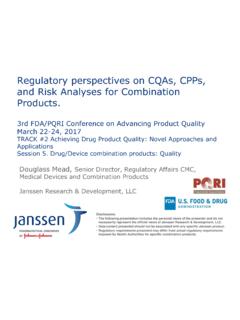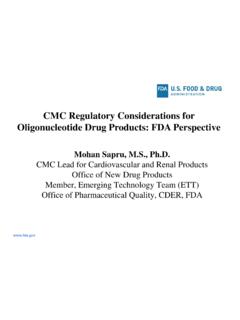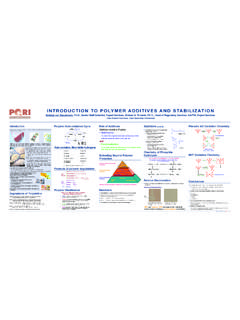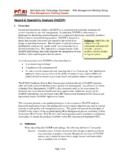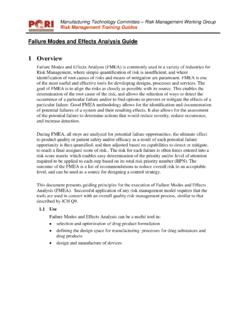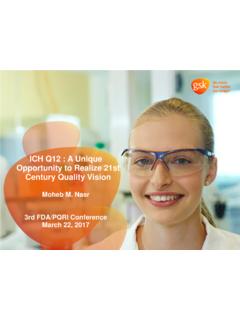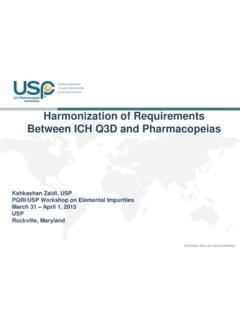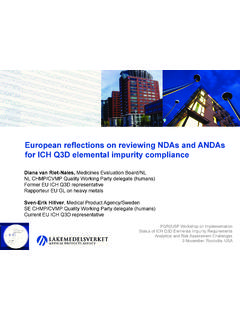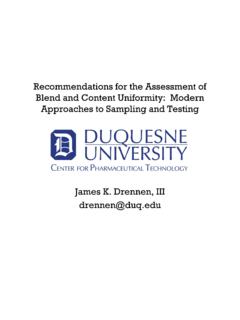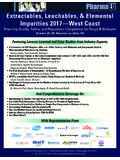Transcription of Regulatory Perspectives on Extractables and …
1 1 Regulatory Perspectives on Extractables and LeachablesPrasad Peri, ONDQA, FDAFeb 22, 2011 PQRI Workshop on Thresholds and Best Practices for Parenteral and Ophthalmic Drug Products (PODP) Bethesda, of potential leachablesWould you want these in your drug products? Bisphenol A(known teratogen)(1-hydroxycyclohexyl)phenyl-Me thanon, suspected leachableBenzophenoneKnown photo initiatorPVC monomers2 2,4,-bis(1,1-dimethylethyl)-phenol (DTBP)Leachable, toxicity to be determined3 Definitions Extractables Compounds that can be extracted from the container closure system (CCS) when in the presence of a solvent leachables Compounds that leach into the dosage form from the container closure as a result of direct contact with the formulation4 Definitions Extractables Compounds that can be extracted from the container closure system (CCS)
2 When in the presence of a solvent leachables Compounds that leach into the dosage form from the container closure as a result of direct contact with the formulation5 Outline Regulatory Background/Importance Recommendations Current Status QbD Approaches to Extractables and leachables Conclusion6 Background How did the importance of Extractables / leachables come to FDA s attention? In the early 1990s. Nitrosamines in metered-dosed inhalers elastomers (MDIs) 2-Mercaptobenzothiazole in elastomers Other classes of E/L s Processing aid residues Vanillin in inhalation solution Aluminum in large volume parenterals7 Why the Concern? Safety concerns MDIs Sensitive, compromised patient populations Paradoxical bronchospasm Long-term safety for chronic use Parenterals Direct exposure to leachables Quality concerns Lack of knowledge/control of source materials Lack of understanding of potential risks from Extractables and leachable Lack of control of Extractables and leachables8 Relevant Recent Meetings/Courses PDA Extractables and leachables Nov 6-8, 2007, Bethesda, MD.
3 PharmaEd s Extractables and leachables 2010, May 2010, San Francisco Extractables and leachables for Pharmaceuticals Products, 14-15 Sept 2010 (London). PDA/FDA Joint Regulatory Conference, 13-16 Sept 2010, Washington DC. leachables and Extractables Testing and Assessment, Nov. 2010, Prague Czech Republic. IPAC RS Workshop on Extractables and leachables 2011 March. Extractables - leachables Forum 2011, May 17-18, 2011 in Goettingen, Germany9 Cindy Zweiben, Characterization of Extractables and leachables in Parenteral Drug Products, Sept 2010 Potential for Extractables and Leachables10 Present and Future Only in the past 15 years have attempts been made to proactively design materials fit for use based on increased knowledge about container closure system (CCS) materials and manufacturing processes.
4 There is room for a risk-based approachfor ophthalmic and someparenteral drug products regarding E/L studies Likelihood of CCS formulation interaction Potential risk to the patient based on the route of administration. If risks not known, can use conservative approaches ( , MDI/DPI)11 Extractables Studies Why? For qualification of CCS components Used to screen for and monitor presence of toxic materials ( , nitrosamines etc.) Used for quality control for acceptance of CCS components Extractables limits ensure limitations on leachables when Extractables are correlated to Use knowledge of component composition as an initial guide to developing the extraction techniques and analytical methods Use solvents of varying polarity, multiple extraction techniques and analytical techniques Estimate daily exposure, and safety concern threshold Involve toxicologists in assessmentExtractables Studies How?
5 13 Extractables Studies How? Extraction Water Polar solvents Organic Solvents14 leachables Studies How? Conduct leachables studies (during drug product stability testing) based on methods used for controlled Extractables studies. When possible establish a correlation between Extractables & leachables Could be possible to eliminate leachables testing and develop routine Extractables ApproachReactive ApproachQbDA systematic approach, predefined objectives, product and process understanding and process control, science, quality risk Risk ManagementProactive ApproachEnhanced Assessment ofProduct UnderstandingPharm. Quality System16 ICH Quality QualityQuality RiskManagement(Q8R)(Q9)(Q10)Q8, Q9, and Q10 work together as a foundation for Pharmaceutical Quality17 ICH Q8(R2) Concepts Quality should be built in by design Enhanced product knowledge and process understanding Facilitates establishment of design space Provides opportunities for flexible Regulatory approaches Risk-based Regulatory decisions (review & inspection)
6 18 Role of Quality Risk Management Role of risk assessment Early identification of risk Risk analysis and evaluation Risk reduction as needed Risk communication for continuity between Development and manufacturing Industry and regulators Multiple manufacturing sites Review of risk can be incorporated On periodic basis As part of investigations of deviations As part of change control and continuous improvement19 QbD Approachto Extractables and leachables Desired product profile Critical quality attribute (CQA) Minimum level or absence of leachables Formulation and CCS selection and design to consistently meet CQA Risk assessment to identify source of variability (material, process) on CQAs Design and implement a control strategy Manage product lifecycle, including continual improvementProduct profileCQAsRisk assessmentDesign SpaceControl strategyLifecycle management20 QbD Approachto Extractables and LeachablesProduct profileCQAsRisk assessmentDesign SpaceControl strategyLifecycle management QTPP-Acceptable levels of leachables Considerations Dosage form and route of administration Patient population Chronic vs.
7 Short-term use Patients daily exposure Formulation that is stable and not reactive Delivers consistent product performance Container closure systems with low and safe levels of leachables21 CCS Understanding Anthony Grilli, leachables and Extractables Testing, A Primer on Regulations and Methods ExtractablesLeachables Not all Extractables are leachables Not all leachables are extractable When possible, develop a correlation between Extractables and leachables Control and/or characterize the leachables that are Assessment Understand risks of E/L Dosage form risk Inhalation, parenteral > ophthalmic > transdermal > oral > topical Patient population For example, highly sensitive or immune compromised patients Use prior knowledge for selecting and studying CCS For example, high pH formulations and glassProduct profileCQAsRisk assessmentDesign SpaceControl strategyLifecycle management23 Risk Assessment E/L sExtractables and LeachablesResinsPlasticizers, Additives, ElastomersRelease Agents Formulationexcipientssensitivity MethodsSpecificationsStability,Storage Understand potential contributing factors toward E/Ls24 Designing the Product Material selection for CCS components is driven by Safety assessment of Extractables / leachables Desired performance parameter outcomes Formulation compatibility considerations Primary vs.
8 Secondary packaging components Elevated risks for packaging components in contact with drug or patient Work with supplier Understand CCS manufacturing process and composition, as much as possible, especially for higher risk components Make safety assessment of materials to guide the choice of materials and to decrease risk later in development Product profileCQAsRisk assessmentDesign spaceControl strategyLifecycle management25 Understanding the Process Understand sources of variability for each material, component, and processing used in the CCS Evaluate the impact of this variability on CCS performance and safety as it pertains to drug product Rational experiments Determine who (NDA applicant or supplier) will do experiments Work with supplier(s) to ensure appropriate raw material quality, in-process/release controls for CCS components to maximize chances for successful developmentProduct profileCQAsRisk assessmentDesign spaceControl strategyLifecycle management26 Design SpaceMaterials -Process -ProductProductMaterialsDesign SpaceProcessWhile it is possible to have a Design space for CCS, it is not necessary as part of a QbD Strategy Prior knowledge useful as a starting point.
9 The planned set of controls, derived from current product and process understanding that assures process performance and product quality Control strategies can include parameters and attributes related to materials and components, facility and equipment operating conditions In process controls finished product specifications associated methods and frequency of monitoring/control move the control upstream ( Extractables ) to where the source of variability is likely. leachables testing when necessaryProduct profileCQAsRisk assessmentDesign spaceControl strategyLifecycle managementLeachablesExtractablesSetting leachables SpecificationDrug substance, formulation, excipientsCCS materials selectionLeachables dataFabricatorComponent mfg.
10 Process(oils, detergents, soaps, processing aids)Analytical methodsDevice operation(pressure, temp)Stability/storageconditionsReaction kineticsIdentification & qualificationDrug product manufacturing processSpecification29 Setting leachables specification is a circular, labor-intensive process if a proactive approach is not adopted Specifications are usually based on data; however, amount of research and development plays a significant role Formulation CCS material Analytical methods If extractable studies are performed ahead of time, the burden of setting leachables specifications becomes easier as an Extractables - leachables correlation can be accomplished in a single stability studyControl Strategy Specifications30 Lifecycle Management Lifecycle monitoring and improvement in CCS material and process Work with suppler related to changes in CCS process Business decisions Alternate sites for better access Better knowledge of materials Development of libraries for alternate CCS materials to be interchanged ahead of time since the component marketplace is constantly changingProduct profileCQAsRisk assessmentDesign spaceControl strategyLifecycle management31 Summary Extractables and leachables (E/L s)
